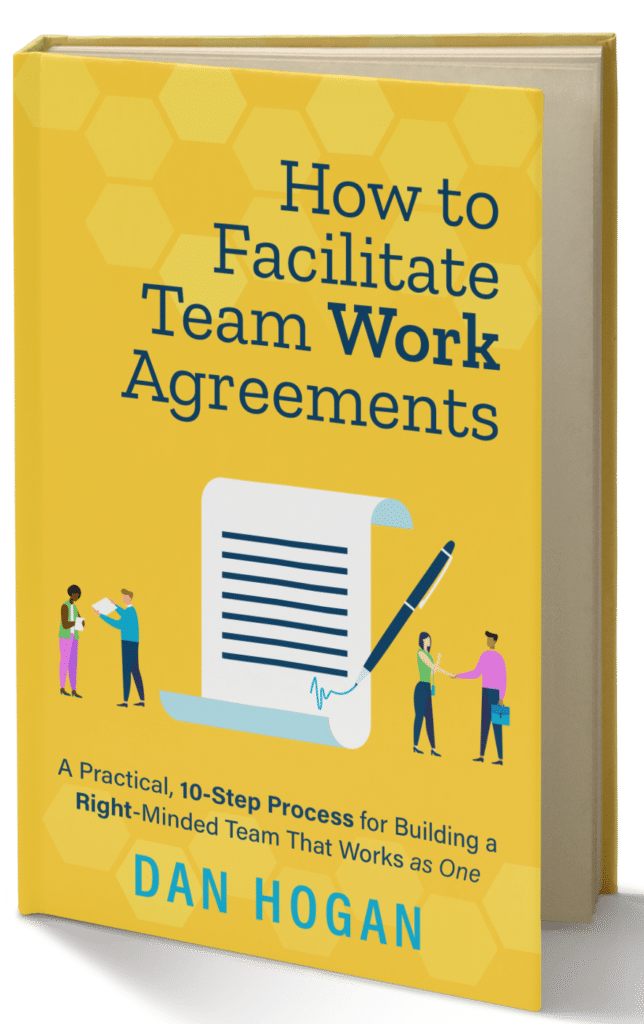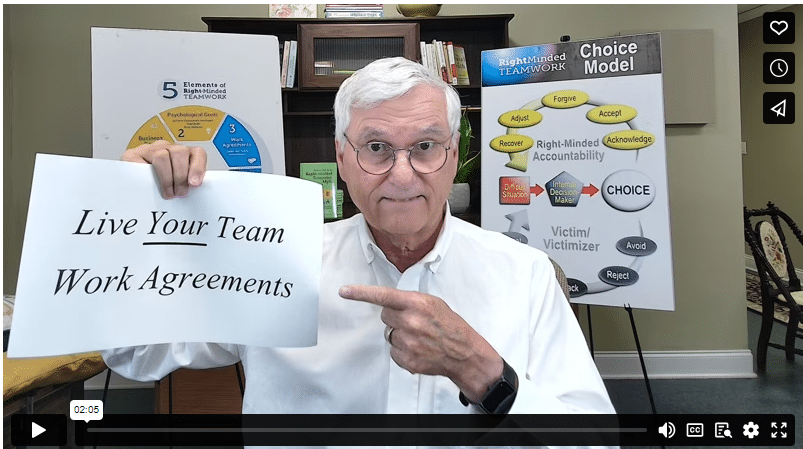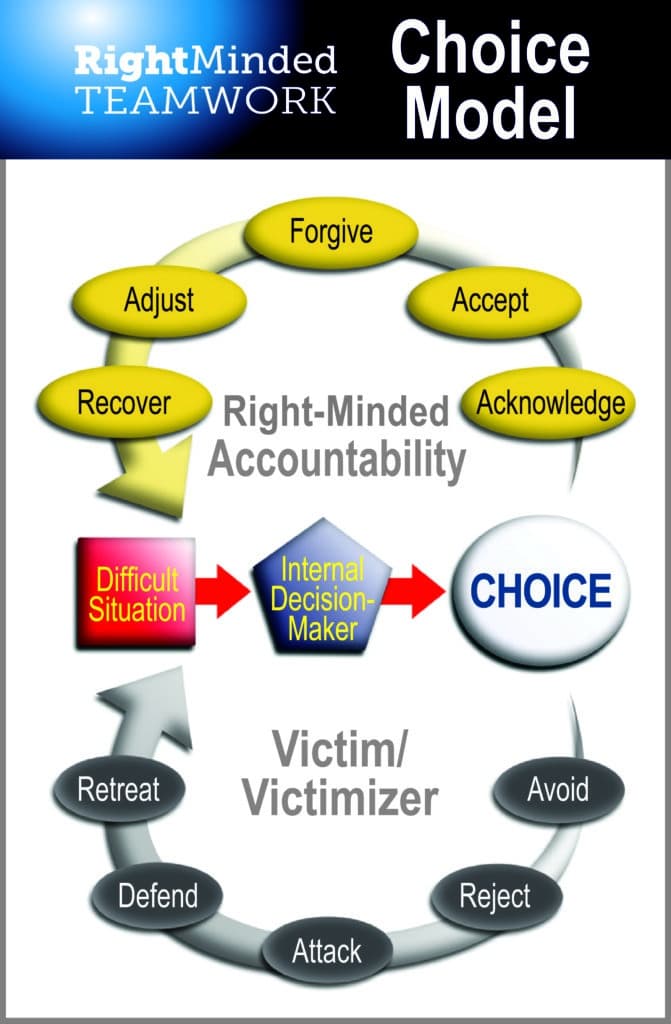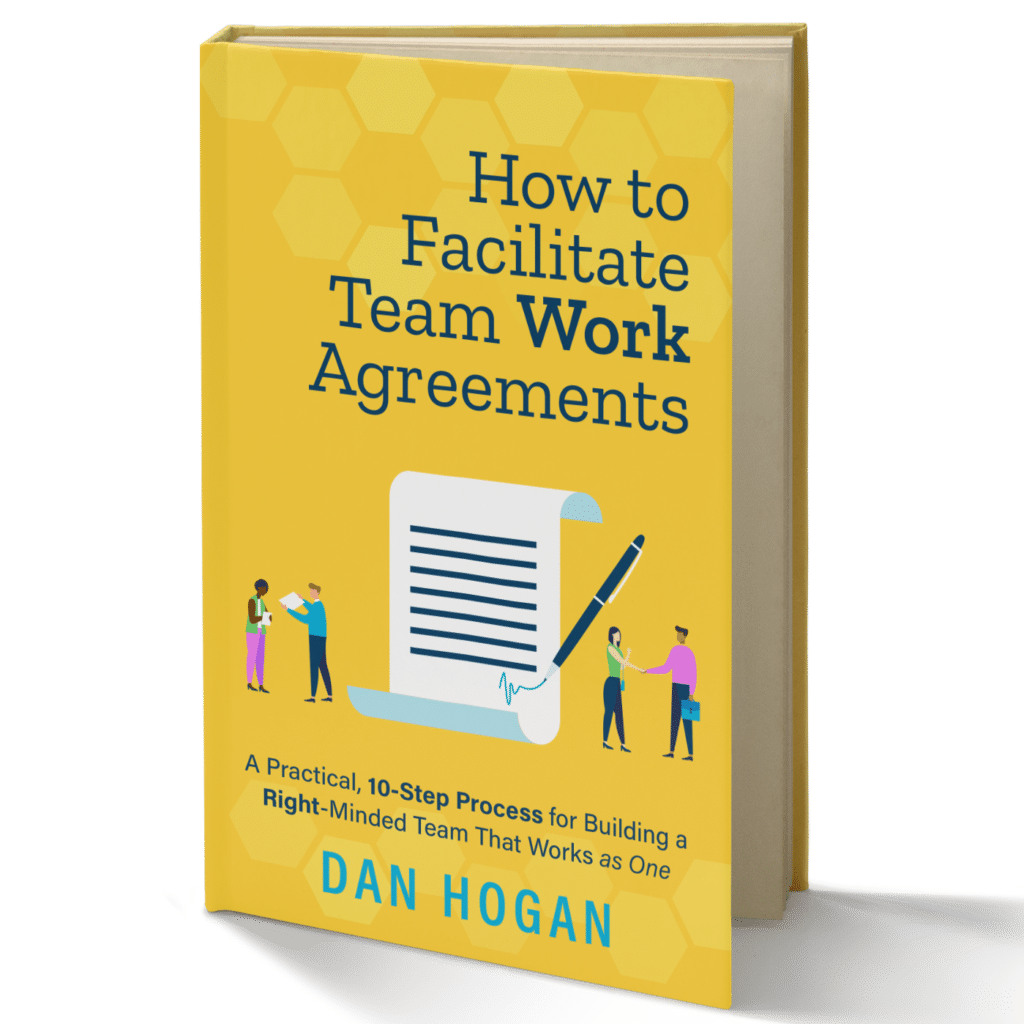Team Work Agreements solve interpersonal and team process issues.
Team Agreements are the means for collaboratively working together to achieve team goals because teammates now Do No Harm while they Work as One.
In this article, you will 1) Learn the 10 facilitation steps, as well as 2) What Work AgreementsA Work Agreement is a collective teammate promise to transform non-productive, adversarial behavior into collaborative teamwork behavior. More are, and 3) Why team Agreements work.
Table of Contents
- Overview of the 10 Basic Facilitation Steps
- What Are Work Agreements plus Two Real Examples
- Why Work Agreements Work
- Your Next Steps – 3 Learning Options
- Video 2:05 Minutes – How to Facilitate Work Agreements
The 10 Practical Steps in Facilitating a Team Work Agreement
Overview
- Agree on the first teamwork topic to address in the team workshop.
- Determine the topic’s desired outcome.
- Design an opening question to be asked to kick off the topic dialogue.
- When the time is right, ask the opening question for your topic.
- Capture behavioral answers on a flip chart.
- Write and propose an intention statement.
- After a short dialogue, ask if teammates agree to live the intention.
- Write clarifications and conditions for acceptance of the intention.
- Create an interlocking accountability condition for times when teammates break the agreement.
- When everyone commits to the Work Agreement, celebrate. Move to the next topic.
A Narrative of the 10 Facilitation Steps
Let’s assume a team leader has asked you to facilitate a one-day RMT Work Agreement workshop. Here are your preparation and facilitation steps.
Preparation Steps 1-3
In Step 1, the team leader informs you, the facilitator, what they want to achieve and why. Often, some difficult situation has occurred that has precipitated the desire for this workshop.
After you understand the leader’s desired teamwork outcomes, you interview all teammates to understand what they want to achieve and why.
After the teammate interviews, you share the team’s collective input with the leader, which results in selecting the teamwork topics to address in the first workshop.
In our teaching example, we will focus on two specific teamwork outcomes for our workshop: improving communication and improving team decision-making. The first is a behavioral issue, and the second is a work process issue.
In Step 2, an agenda is created that includes the desired outcomes.
In Step 3, an opening question is created for both issues: communication and decision-making. As the facilitator, you will ask these questions to launch a team discussion that, eventually, leads to one or more Work Agreements.
The Workshop
Imagine you are 10 minutes into your workshop. The team leader welcomed everyone. All teammates have agreed to the desired teamwork outcomes as well as the agenda, ground rules, and the day’s logistics.
Before you ask your opening question, take five minutes to introduce or review the Right Choice Model. Your goal is to present the Model in such a way that when you finish teaching it, all teammates declare,
Of course, we need to approach [our issue] in a Right-Minded, accountable way. Let’s get started.
Alternatively, the team leader may present the Right Choice Model by relating it to a current team challenge.
Once the team agrees to take a Right-Minded approach to address their issues, you are ready for your opening question.
Opening Question
Asking the opening question, Step 4, should invite an honest discussion on the first teamwork topic. For example, if improving team communication is the desired objective, you might ask, “If we communicated respectfully, what would you see or hear teammates say or do, or not say or do?”
Up to this point in the workshop, you, the facilitator, have been doing most of the talking. After asking the opening question, you move into listening, observing, and facilitating.
Now that the opening question has been asked, you listen to the team’s discussion, which may last 30 to 60 minutes. All the while, you capture legitimate behavioral answers on a flipchart – Step 5.
In Step 6, while teammates continue to discuss their workshop topic, you think about and write an intention statement. The proposed statement should evolve from the team’s list of behavioral answers. When the time is right, you suggest the intention statement, which, in our example, might sound like, “Each teammate will communicate in a respectful way with each other and our customers.”
In Step 7, you ask teammates if they will agree to live the proposed intention. Most of the time, teammates agree, though they may assert it needs more work. This brings you to Step 8.
Will the Agreement Work?
In Step 8, the team discusses their specific clarifications or conditions for acceptance of the intention statement. As teammates add and edit their conditions, you periodically ask them, “If you truly lived your Work-Agreement-in-progress, would you achieve your desired outcome?” Most of the time, they will say yes. This “yes” motivates the team to continue making the “right” Agreement for the team.
Finally, Step 9 calls for “interlocking accountability” within the Work Agreement – a crucial part of encouraging the team to live their Agreements day in and day out. Fortunately, you will only need to create interlocking accountability once as it will apply to all Work Agreements.
For a real-world example of an interlocking accountabilityInterlocking accountability is a crucial RMT concept that is primarily used in How to Facilitate Team Work Agreements. More statement, go to Real Team Work Agreements below, see the 1st Agreement – Behavioral Communication Agreement, and find the final condition “I” at the bottom that begins with “If someone continues to break this agreement, we will…”
In Step 10, every teammate publicly commits to hold themselves and others accountable for upholding the team Work Agreement. At this point, everyone should genuinely believe the Agreement will help the team achieve its goals.
NOTE: It is not unusual for teammates to break their Work Agreements after the workshop. Often, this breach is just an honest mistake, or a habit not yet transformed. However, if a teammate continues to break a Work Agreement, the team should have an agreed-upon condition within their Agreement that clarifies how they will confront one another. This is the interlocking accountability condition created in Step 9.
Those are the basic facilitation steps. Now, let’s look at the two basic types of agreements and two real examples.
What Are Team Work Agreements?
A Work Agreement is a promise to transform non-productive work behavior. It is not a flimsy ground rule. It is an emotionally mature work performance agreement.
There are two types of Work Agreements:
- A Process Agreement describes who will do what and the respective work methods they will use. This Agreement consequently defines roles and responsibilities, interfaces, and procedures.
- A Behavioral Agreement describes how people will behave while they perform their tasks. This Agreement defines how teammates will resolve difficult issues or interpersonal conflict striving for transparency in all interactions.
Between the two, all teamwork issues are suitable for team Work Agreements.
Two Real Team Work Agreements
Below you will find two real examples. The first one is a behavioral team Communication Work Agreement. The other is a process, Decision-Making Work Agreement.
I worked with this team for a few years. They were phenomenally successful Agreements because teammates passionately created and actively lived them day in and day out.
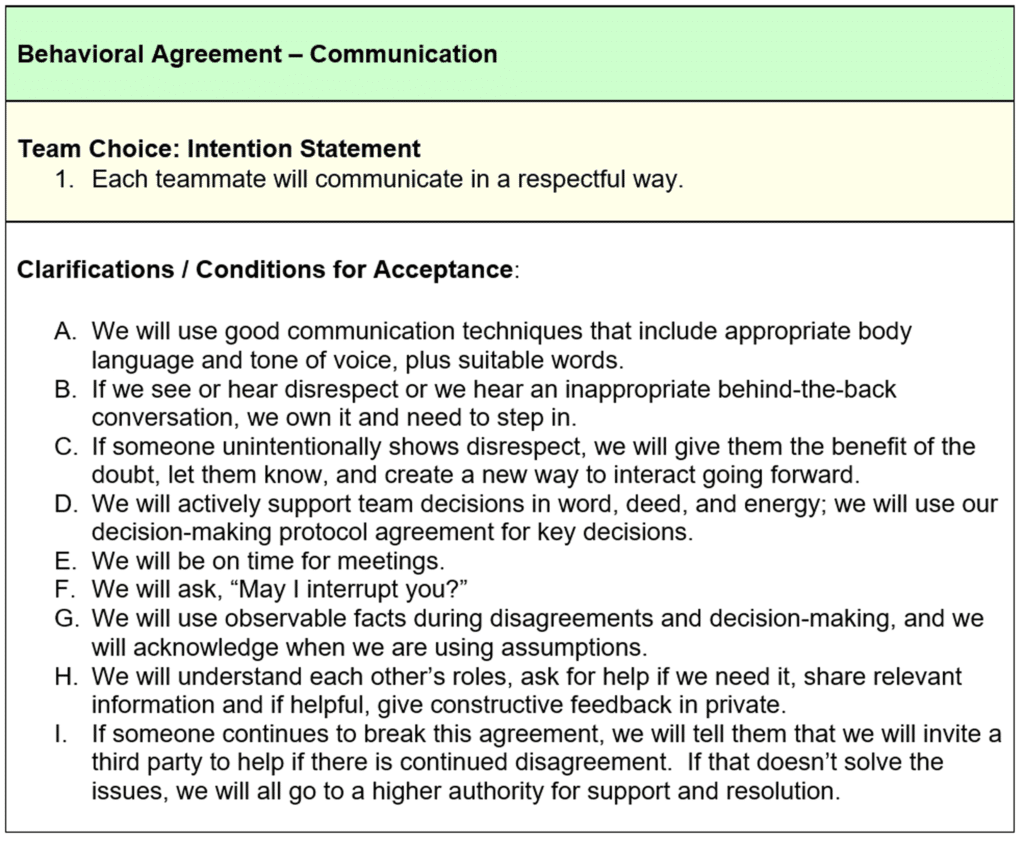
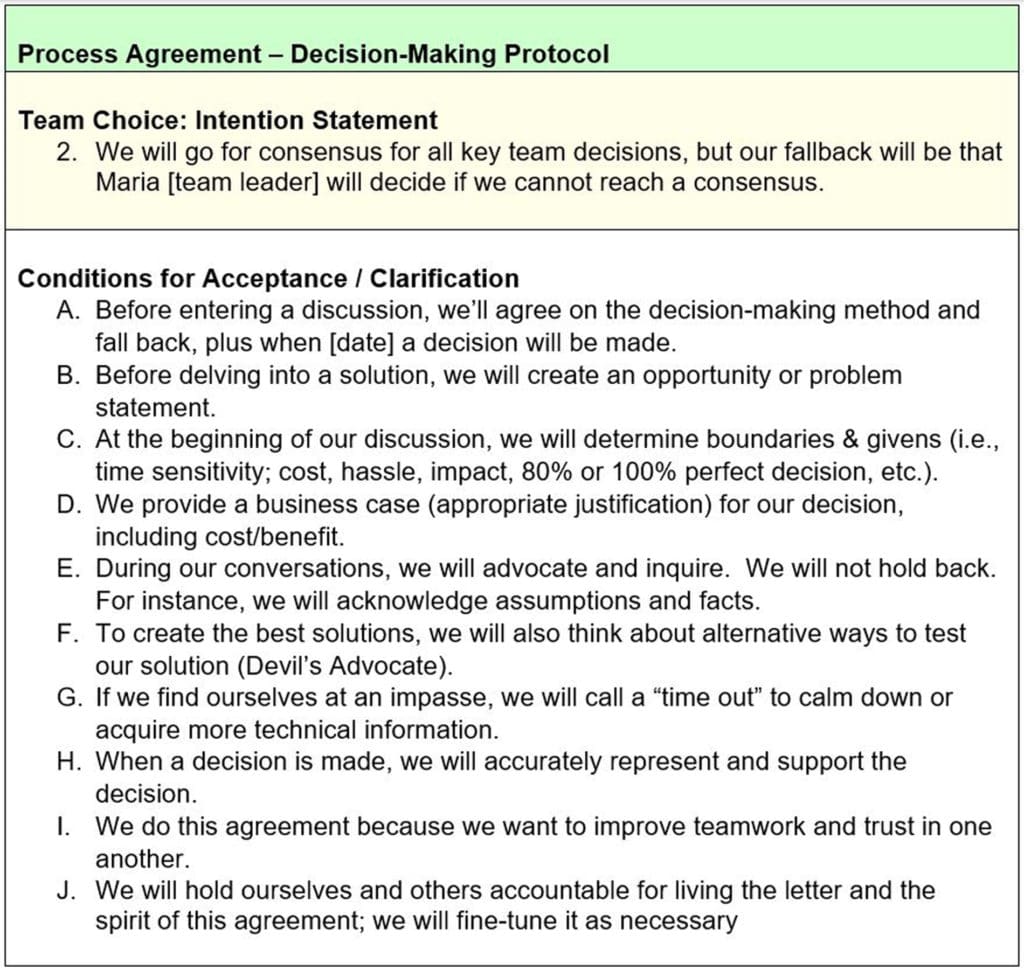
With my guidance, it took this 10-person team about 3 hours to create these two Work Agreements. Use your imagination as to what they said to each other that made this successful agreement.
Why Team Agreements Work
I facilitated over 500 teams in eight countries in my 35-year team-building career. I worked with many of those teams for several years. Every team created some kind of “fit-for-purpose” team Work Agreement and every team grew and succeeded because of it.
Work Agreements work when teammates live and follow them. Here’s why:
It is not a matter of IF conflict will happen, but WHEN conflict happens among teammates.
This truth alone is enough justification for creating team Work Agreements.
It is far better to have Work Agreements in place before conflict happens. But even if your team is currently in conflict, it is never too late to create and follow Work Agreements.
The team’s compelling story above is a prime example of how Work Agreements help teams. But it is certainly not the only one.
This success can happen in your team, too.
Your Next Steps – 3 Learning Options
- To learn more about a real team SUCCESS Story, read this short article. It will help you decide to buy the book and learn this valuable teamwork tool.
2. Buy the ebook PACKAGE here ar Right-Minded Teamwork includes
- Ebook: PDF & ePub, 266 pages with step-by-step instructions and real-world examples
- Word Document: How to Facilitate Team Work Agreement – Reusable Resources [these are ONLY available here at the Right-Minded Teamwork website]
- PDF: How to Facilitate Team Work Agreements – Resources
3. Buy the Paperback Book at Amazon or Barnes & Noble
How to Facilitate Work Agreements – 2:05 Minute Video
Get Started
In the thirty-five years of my team-building career, I facilitated over 500 teams in varying states of conflict and dysfunction. Every team created Work Agreements of some kind and succeeded as a result.
I know beyond a shadow of a doubt that Work Agreements work when teammates live them. They are right for every team, everywhere, forever. If you use them, I promise they will help make your team(s) and the world a better place.
Let’s get started right now.
May Oneness be With You & Your Teammates 🙏
